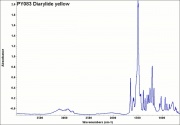Difference between revisions of "Diarylide dye"
Jump to navigation
Jump to search
m (Text replace - "== Authority ==" to "== Sources Checked for Data in Record ==") |
|||
| Line 18: | Line 18: | ||
Highly toxic. Suspected carcinogen and teratogen. May cause bladder cancer. . | Highly toxic. Suspected carcinogen and teratogen. May cause bladder cancer. . | ||
| − | == | + | == Sources Checked for Data in Record == |
* Michael McCann, ''Artist Beware'', Watson-Guptill Publications, New York City, 1979 | * Michael McCann, ''Artist Beware'', Watson-Guptill Publications, New York City, 1979 | ||
Revision as of 19:40, 30 April 2016
Description
A class of synthetic yellow, orange, and red organic colorants. Diarylide dyes are insoluble direct azo dyes that were first synthesized from benzidine in 1911. They were not widely used until the 1930s. Diarylide yellows have good tinting strength, opacity and solvent resistance. They have fair to good lightfastness and are primarily used in printing inks, plastic, rubbers, as well as architectural and artists paints.
See also Arylide.
Synonyms and Related Terms
diarylide dyes; disazo dye; benzidine yellow; Pigment Yellow 12; Pigment Orange 13; Pigment Red 41; Pigment Yellow 83; benzidine orange
Other Properties
Resistant to alkalis and heat.
Hazards and Safety
Highly toxic. Suspected carcinogen and teratogen. May cause bladder cancer. .
Sources Checked for Data in Record
- Michael McCann, Artist Beware, Watson-Guptill Publications, New York City, 1979
- Monona Rossol, The Artist's Complete Health and Safety Guide, Allworth Press, New York, 1994
- Thomas B. Brill, Light Its Interaction with Art and Antiquities, Plenum Press, New York City, 1980
- B. Berrie, S.Q. Lomax, 'Azo Pigments: Their History, Synthesis, Properties and Use in Artists' Materials', Studies in the History of Art , National Gallery of Art, Washington DC, No. 57, 1997
